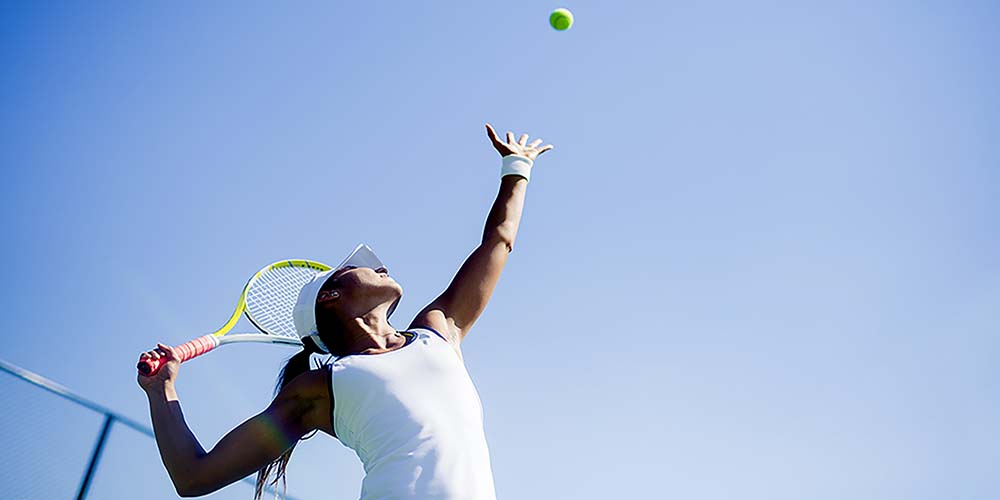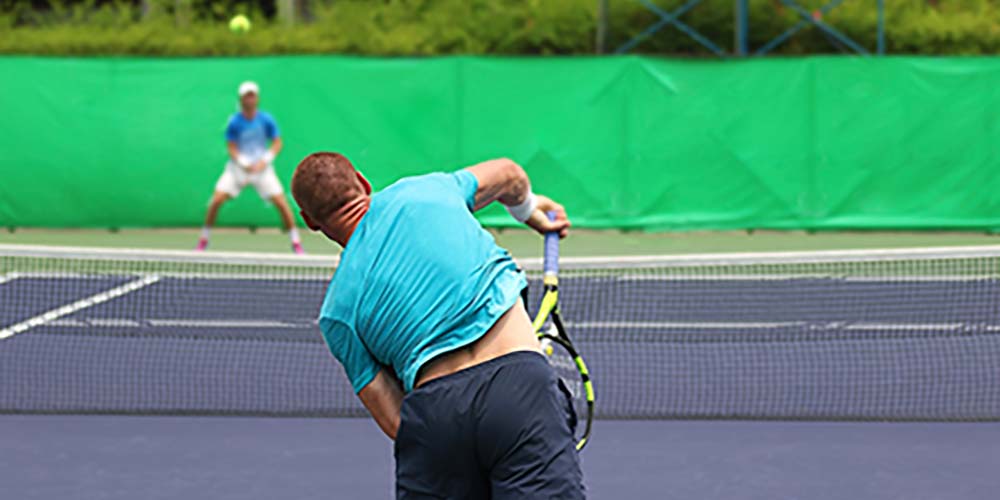Hitting a serve in tennis can be a complicated task for many. After all, there is so much involved. The grip, ball toss, footwork, and there is an element of rhythm and timing that is difficult to master without practice. For some, these things come easy. If you don't fall into that group, follow these keys to improving your serve.
The Grip
Gripping the racket properly is important to achieve a good serve. There are 2 main grips to choose from. The Eastern Forehand grip and the Continental grip.
Eastern Forehand Grip
To hit the Eastern forehand grip, place your hand flat on the racket strings. Then slide your hand down to the handle. Wrap your fingers around the racket. Your first finger should be forward slightly. Be sure to keep the tension out of your fingers. While this is difficult to remember at times it will pay off in the end. This grip is often referred to as the "shaking hands grip" because you are essentially shaking hands with the racket. With the Eastern forehand grip, you are more likely to hit the ball flat or without spin. Flat serves do not have as much clearance over the net. For that reason, some beginning players can opt to use the more proper serving grip.
Continental Grip
The proper technique used for the Continental grip is to place your palm 45 degrees counterclockwise from the Eastern forehand grip. With the Continental grip the racket face will tilt slightly upward. It is possible to hit flat with the Continental, but to do so you must make contact with the ball farther back than usual. This grip will allow you to create more spin on the ball. Creating the correct combination of side spin and force is what makes a great serve.
Tossing the Ball

Tossing a ball in the air seems simple enough. But if you throw the ball slightly forward or backwards it makes it much more difficult to execute a winning serve. You want to toss the ball on an imaginary line from your hand to where you are going to hit it. Release the ball as high as possible. If you release the ball down by your chest it makes it harder to hit your spot. Be sure to extend your arm and release above your head. Keep your hand in a locked position so help the ball stay on course.
Different serves require different tosses. This is another important factor about the ball toss which beginner tennis players should practice. For example, during a flat serve keep the ball at your right side and in front of you. Avoid tossing the ball too far in front. On the other hand, during a slice serve, the ball should be tossed over your head and a little towards the right side for right-handed players. Understanding where to throw the ball is half of the battle to serving.
Hitting the Serve
While tossing with your non-dominant hand, your hitting arm should swing backward to begin the striking motion. As soon as you have released the tennis ball, begin bending both your knees and your elbow. Remember to keep your elbow fully bent, your wrist relaxed, and your racket hanging down behind you. Doing these things will help you to get the most accuracy and power in your serve.
Using Your Lower Body
The lower body is very key when hitting a proper serve. As you begin to toss the ball your legs should begin to straighten. As this happens your swing arm will begin move back and begin the swing. Your legs help to create the power needed for the serve taking the strain off your arm.
Contact Point
To know how to serve in tennis you also need to know how to make contact with the ball in the right spot. To hit a fairly flat serve, you should hit the ball at full upwards extension, approximately ten to twelve inches farther forward than your head, and ten to twelve inches to the dominant side of your head. You should attempt to see your racket hit the ball. Continue looking at the contact point for a second afterwards, particularly when you're just learning how to serve in tennis.
Follow Through

Once you've hit the tennis ball, your dominant foot will likely come forward. Also, as you're learning how to serve in tennis, you may find that during your follow-through you occasionally hit yourself in the legs with your racket. You'll learn to always bypass your legs on the follow-through with more practice.
Stay Relaxed
Many tennis players have the skills but don't know how to relax during the game. Relaxation is especially important when you are serving because you cannot afford tensed muscles during the serve. Most beginners try to force the serve. Instead allow your body to create the serve. Relax your wrist and arm by resting your racquet on your tossing arm before you begin your motion. This will retain the elasticity in your muscles. Also don't forget to breathe in and out through nose through out the game. It takes practice, time, and patience to learn how to serve in tennis. Once you do learn how to serve in tennis, you'll enjoy the game on an entirely new level. It can be frustrating at times, but with a little practice anything is possible.
Summary
Serving in tennis can be a huge advantage. Practice your serve today and win more games. Learning how to throw the ball correctly, hold the racket, and following through should help you to win more points.